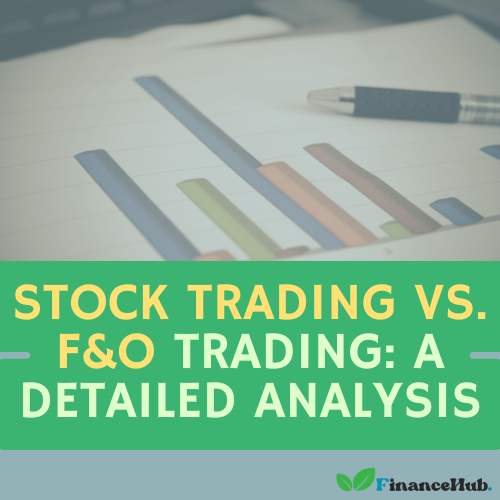1. Introduction
Investing and trading in financial markets offer multiple avenues for wealth creation. Two of the most popular methods are stock trading and F&O (Futures & Options) trading. While both involve equities, their mechanics, risks, and rewards differ significantly.
This analysis explores the fundamental differences, advantages, and risks associated with stock trading and F&O trading to help investors make informed decisions.
2. Understanding Stock Trading
Definition & Basics
Stock trading involves buying and selling shares of publicly listed companies with the goal of making a profit. Investors can trade stocks on exchanges like the NSE (National Stock Exchange) and BSE (Bombay Stock Exchange).
Types of Stock Trading
- Intraday Trading – Buying and selling stocks within the same trading day.
- Short-Term Trading – Holding stocks for a few days to weeks.
- Swing Trading – Holding stocks for weeks to months based on market trends.
- Long-Term Investing – Holding stocks for years (fundamental investing).
Advantages of Stock Trading
✅ Ownership Rights – Shareholders get voting rights and dividends.
✅ Lower Risk – No leverage means controlled losses.
✅ Simplicity – Easier to understand for beginners.
✅ Dividend Income – Some stocks provide regular payouts.
Disadvantages of Stock Trading
❌ Limited Leverage – No amplified gains like derivatives.
❌ Slower Returns – Long-term investments take time.
❌ Market Risk – Prices can fall due to economic factors.
3. Understanding F&O (Futures & Options) Trading
Definition & Basics
F&O trading involves contracts where traders speculate on the future price of an asset without owning it. These are derivative instruments based on underlying stocks, indices, or commodities.
Types of F&O Contracts
- Futures Contracts – Agreement to buy/sell an asset at a predetermined price on a future date.
- Options Contracts
- Call Option – Right to buy an asset at a fixed price.
- Put Option – Right to sell an asset at a fixed price.
Advantages of F&O Trading
✅ High Leverage – Small capital can control large positions.
✅ Hedging – Protects against stock market volatility.
✅ Short Selling – Profit from falling markets.
✅ Flexibility – Multiple strategies (straddle, strangle, spreads).
Disadvantages of F&O Trading
❌ High Risk – Leverage can lead to significant losses.
❌ Complexity – Requires deep market knowledge.
❌ Time Decay (Options) – Loses value as expiry nears.
❌ Margin Calls – Can lead to forced liquidation.
4. Key Differences Between Stock and F&O Trading
| Factor | Stock Trading | F&O Trading |
|---|---|---|
| Ownership | Direct ownership of shares | No ownership, only contracts |
| Risk Level | Moderate (depends on holding) | Very High (leverage & expiry) |
| Leverage | Limited or none | High (5x-10x exposure) |
| Time Horizon | Flexible (days to years) | Fixed expiry (weekly/monthly) |
| Profit Potential | Depends on stock movement | Higher due to leverage |
| Margin Required | Full payment (usually) | Margin-based (lower upfront) |
5. Which is Better? Stock Trading or F&O Trading?
For Beginners
✔ Stock Trading is Better – Simpler, lower risk, and no expiry pressure.
For Experienced Traders
✔ F&O Trading Can Be Better – Leverage and hedging provide advanced strategies.
For Long-Term Investors
✔ Stock Trading is Ideal – Compounding and dividends work better over time.
For Short-Term Traders
✔ F&O Trading Can Be Profitable – Quick gains with leverage, but high risk.
6. Risks Involved in Both Markets
- Stock Trading Risks: Market crashes, company bankruptcy, liquidity issues.
- F&O Trading Risks: Unlimited losses (futures), time decay (options), margin calls.
7. Regulatory Framework & Taxation
- Stock Trading:
- STT (Securities Transaction Tax) – 0.1% on delivery trades.
- Capital Gains Tax – Short-term (15% if sold within 1 year), Long-term (10% over 1 year).
- F&O Trading:
- STT – 0.01% on options, 0.025% on futures.
- Taxation – Always treated as business income (no LTCG benefits).
8. Conclusion
- Stock Trading is safer, simpler, and better for long-term wealth creation.
- F&O Trading offers high rewards but comes with extreme risk and complexity.
Final Recommendation: Beginners should start with stocks, while experienced traders can explore F&O with strict risk management.

Sekhar Gour is the creator of Finance Hub Assam. A finance enthusiast with a knack for simplifying complex money matters, Sekhar offers practical insights tailored to Assam’s economic scene. When not writing, he enjoys exploring local culture and market trends.

